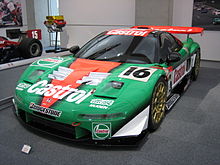Dome (company)
| Dome
|
|
|---|---|
| legal form | Kabushiki-gaisha (joint stock company) |
| founding | 1978 |
| Seat | Maibara , Japan |
| management | Minoru Hayashi |
| Branch | Automobiles , motorsport |
| Website | www.dome.co.jp |
Dome ( Jap. 株式会社童夢 , Kabushiki-gaisha DOMU , literally " childhood dream ", Eng. Dome Co. Ltd. ) is an officially in 1978 Takaragaike at Kyoto registered Japanese companies for the development, design and construction of racing cars , Vehicle parts and prototypes for the automotive industry. Since 1987 the head office has been in Maibara ( prefecture Shiga ), with two subsidiaries ( Dome Carbon Magic and Dome Tunnel ) in the same city and a European branch in Chessington, a district of Kingston upon Thames in the British county of Surrey . The president of the parent company is race car designer and company founder Minoru Hayashi. Dome became known mainly through the cooperation with Honda and its subsidiary Mugen from 1996 onwards in the development of the racing version of the Honda NSX for the Japanese GT Challenge at the time and with a championship title for the Mugen- Dome team in 2000. Dome also achieved a positive public image through various prototypes and a small series of the Dome-Zero sports car project as well as through operations in the Le Mans 24-hour races and the American Le Mans Series in collaboration with the British engine manufacturer John Judd .
history
Hayashi had already built his first racing car based on the Honda S600 , the Karasu , in 1965 , and numerous other custom-made products followed under the Hayashi Racing label . In 1975 the Dome project was started in parallel with the racing car construction . According to the company the goal of a small and lightweight that time was mid-engine - sports cars to build constructions race car should be included in the experience of. In the spring of 1978, the almost 910 kg Dome-Zero prototype with a roughly 140 hp 2.8-liter engine from the Datsun 280Z was presented at the Geneva Motor Show, and the company was officially founded in the same year. By 1979, the designers had developed the first prototype into a second pre-production model called the Dome P-2 for a production-ready sports car and presented it in the USA at the Chicago Auto Show and the Los Angeles Auto Expo . Derived from this, the company produced two copies of the racing version Dome Zero RL , which were used in Le Mans in 1979. Both cars were driven by British Le Mans connoisseurs, but did not reach the destination due to technical problems (fuel supply, cylinder head gasket). Since neither the Dome-Zero nor the Dome P-2 was approved for road use in Japan, the sports car project was subsequently discontinued, but the basic design continued to live in the RL and RC racing car series, which were regularly used in the following years Le Mans drove and made the company name Dome increasingly known. Another project began in 1988 in collaboration with the fashion manufacturer Wacoal Corporation and was presented in 1990 at the Tokyo Motor Show under the name Jiotto Caspita . A planned series production of it did not take place due to a lack of interest. The project finally ended in 1993. Only three copies of the model were assembled in 1988 and 1990.
Formula 1 project
According to his own statements, Minoru Hayashi had the long-term goal of Formula 1 in mind from the start, which he had not yet achieved (as of October 2007). Concrete attempts in 1996 and 1997 to install a Japanese Formula 1 team using exclusively Japanese technology failed. Further steps on the way to a Formula 1 participation were the opening of a British branch in December 1999, since most Formula 1 teams operate from Great Britain, as well as the construction of the Dome Tunnel wind tunnel in Maihara in 2000 (later opened in Maibara), in which the aerodynamics of vehicle models can be tested on a 1: 2 scale. This facility is described by Dome as "indispensable for a Formula 1 designer". In addition, the subsidiary Dome Carbon Magic was established in 2001 in Mishima ( Shizuoka Prefecture ) for the development and production of parts made of carbon fiber reinforced plastic ; also an important element in the construction of modern formula racing cars and their monocoques . In 2004, the various dome activities in Japan were brought together in a new company headquarters in Maibara, which was completed at the end of 2005.
Individual evidence
- ↑ Race Archive on the official Super GT website ( Memento from April 27, 2006 in the Internet Archive )
- ↑ Data sheet of the Dome-Zero (at conceptcarz.com, English)
- ↑ Results list Le Mans 1979
- ↑ Introduction of the series of "Dome F1 Adventure Behind The Scene Story" (Dome website from April 30, 2002, English)



